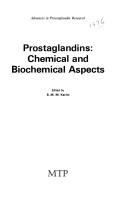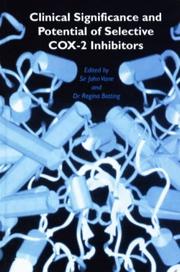| Listing 1 - 10 of 36 | << page >> |
Sort by
|

ISBN: 0852001428 9401196508 9401196486 9780852001424 Year: 1976 Publisher: Lancaster: MTP,
Abstract | Keywords | Export | Availability | Bookmark
 Loading...
Loading...Choose an application
- Reference Manager
- EndNote
- RefWorks (Direct export to RefWorks)
Prostaglandins --- antagonists and inhibitors --- analysis --- biosynthesis --- Prostaglandin Antagonists. --- 577.171.3 --- Antagonists, Prostaglandin --- Inhibitors, Prostaglandin --- Prostaglandin Antagonist --- Prostaglandin Inhibitor --- Prostaglandin Inhibitors --- Antagonist, Prostaglandin --- Inhibitor, Prostaglandin --- analysis. --- biosynthesis. --- Chemical structure of hormones --- antagonists & inhibitors --- Prostaglandins. --- 577.171.3 Chemical structure of hormones --- Prostaglandin Antagonists --- Inflammation --- Prostanoids --- Mediators --- Prostaglandins - antagonists and inhibitors --- Prostaglandins - analysis --- Prostaglandins - biosynthesis
Book
Year: 2009 Publisher: Bruxelles: UCL. Faculté de pharmacie et des sciences biomédicales,
Abstract | Keywords | Export | Availability | Bookmark
 Loading...
Loading...Choose an application
- Reference Manager
- EndNote
- RefWorks (Direct export to RefWorks)
The aim of this work is based on the hypothesis that some molecules may enhance tumor radiosensitivity by increasing tumor oxygenation (p02). Firstly, the effect of the combination of two treatments (xanthiinol nicotinate and hydrocortisone) was studied using TLT tumor bearing mice, using electron paramagnetic resonance oximetry (EPR). No result was observed. Secondly, the effect of prostaglandins (PGh and PGE 1) was also tested , using TLT tumor bearing mice. An increased p02 was observed for PGiz (the most powerful endogenous vasodilatator). Nevertheless, embolisms at the injection site were observed, requiring changing the administration route. For PGE 1, EPR data clearly demonstrated an increase PO². These results were confirmed by others studies using relaxometry. Together our results show the potential usefulness of the administration of PGE 1 before irradiation L'objectif de ce travail est basé sur l'hypothèse que certaines molécules peuvent améliorer la radiosensibilité tumorale via l'augmentation de l'oxygénation tumorale ( PO²i). Premièrement, l’effet d'une combinaison de deux traitements (xanthinol nicotinate et hydrocortisone) a été étudié sur des souris porteuses d'une tumeur TLT, par oxymétrie par résonance paramagnétique électronique (RPE). Les résultats obtenus ne furent pas concluants. Deuxièmement, l'effet de prostaglandines (PGli et PGE 1) a également été testé sur des souris porteuses de tumeurs TLT. Une augmentation de p02 a pu être observée pour la PGh (vasodilatateur endogène le plus puissant). Néanmoins des phénomènes d'embolie au site d'injection obligeraient de changer la voie d'administration. Pour la PGE 1, des études de RPE ont clairement démontré une nette augmentation de la p02.Ces résultats ont été confirmés par des études de relaxométrie au fluor 19. Ces résultats montrent la potentielle utilité de l'administration de la PGE 1 avant l'irradiation.
Xanthinol Niacinate --- Hydrocortisone --- Prostaglandin Antagonists --- Tumor Microenvironment
Book
Year: 2014 Publisher: Bruxelles: UCL. Faculté de pharmacie et des sciences biomédicales,
Abstract | Keywords | Export | Availability | Bookmark
 Loading...
Loading...Choose an application
- Reference Manager
- EndNote
- RefWorks (Direct export to RefWorks)
Cyclooxygcnascs are not limited to metabolism of arachidonic acid.Indeed COX-2 can metabolise other substrates, like 2-arachidonoyglycerol, and consequently form derived prostaglandins like PG-G. Properties of these products could be more studied to create new therapeutical classes of drugs and to understand a little more the effects of marketed NSAIs. Based on the current state of the art, we can already say that PGE2-G activates macrophages. PGF2α-G has similar effects to PGF2-G on macrophages. Researchers have also found anti-inflammatory molecules that can selectevely inbihit the metabolism of endocannabinoïds by COX-2 compared to the metabolism of arachidonic acid. Researches continue to investigate in this direction but also towards the inhibition of other enzymes like MAGL, ABDH6 and FAAH that play a role in 2-AG metabolism. La voie des cyclooxygénases ne se limitent pas à la métabolisation de l'acide arachidonique en prostanoïdes. En effet, la COX-2 peut prendre en charge d'autres substrats (comme le 2- AG) et donc former d'autres produits (comme les PGs-G). Les propriétés de ces produits sont encore peu connues. Mais la connaissance approfondie de ces propriétés physiologiques pourrait mener à terme à de nouvelles classes médicamenteuses et à une plus ample compréhension des AINS classiques. Nous pouvons quand même dès à présent dire que la PGE2-G active les macrophages, induit une hyperalgésie et une activation du NFkB. La PGI2-G active le PPARo et diminue l'expression du facteur tissulaire. La PGD2-G diminue l'activité macrophagique. Et la PGF2a-G agit de manière similaire à la PGE2-G au niveau des macrophages. Les chercheurs ont également pu obtenir un effet anti-inflammatoire par inhibition de l'axe COX-2/endocannabinoïdes sélectivement par rapport à la voie de l'acide arachidonique. Les recherches continuent dans ce sens mais également dans l'inhibition d'autres enzymes de métabolisation de ces endocannabinoïdes (MAGL, ABDH6, FAAH,. ..) dans le but d'unjour mettre au point de nouvelles classes thérapeutiques.
Dissertation
ISBN: 905278129X Year: 1994 Publisher: Maastricht Universitaire pers
Abstract | Keywords | Export | Availability | Bookmark
 Loading...
Loading...Choose an application
- Reference Manager
- EndNote
- RefWorks (Direct export to RefWorks)
Butylated Hydroxyanisole --- Prostaglandin-Endoperoxide Synthases --- pharmacokinetics --- metabolism
Dissertation
Year: 1975 Publisher: Stockholm s.n.
Abstract | Keywords | Export | Availability | Bookmark
 Loading...
Loading...Choose an application
- Reference Manager
- EndNote
- RefWorks (Direct export to RefWorks)
Kidney --- Prostaglandins --- Prostaglandin-Endoperoxide Synthases --- physiology --- biosynthesis
Book
Year: 2018 Publisher: Bruxelles: UCL. Faculté de pharmacie et des sciences biomédicales,
Abstract | Keywords | Export | Availability | Bookmark
 Loading...
Loading...Choose an application
- Reference Manager
- EndNote
- RefWorks (Direct export to RefWorks)
Le métabolisme du 2-arachidonoylglycérol (2-AG) par les cyclooxygenase-2 (COX-2) et différentes prostaglandines synthases permet la production de plusieurs prostaglandines glycérées : PGE2-G, PGF2a-G et PGD2-G. L'activité exercée par ces prostaglandines glycérées est encore peu décrite dans la littérature. Cependant, les premières études évaluant l'action biologique de ces molécules ont montré que la PGE2-G et la PGF2a-G ont une activité pro inflammatoire. Inversement, la PGD2-G exerce un effet anti-inflammatoire. Elle permet, en effet, de diminuer l'activation des macrophages in vitro et exerce une activité anti-inflammatoire in vivo. De plus, de précédentes études au laboratoire évaluant le potentiel analgésique de la molécule dans un modèle de douleur inflammatoire induit par le carraghénane, ont montré que la PGD2-G était capable de diminuer l’œdème et l'hyperalgésie provoqués par l'inflammation. Mais les mécanismes initiés par la PGD2-G pour provoquer ces observations phénotypiques ne sont pas encore compris. Ainsi, l'objectif de ce travail consiste à étudier les médiateurs impliqués dans l'induction des effets de la PGD2-G sur la douleur inflammatoire. Au terme de ce travail, nous avons pu identifier des médiateurs pro-inflammatoires dont les taux varient dans la patte lors de l'administration de la PGD2- G en condition inflammatoire. De plus, des études histologiques ont permis de montrer l'effet de la PGD2-G sur l'infiltration des cellules inflammatoires dans la patte. Enfin, nous avons voulu déterminer si les effets observés dépendaient du récepteur de la PGD2, le récepteur DPl. Nous avons également étudié l'effet de la PGD2-G dans un modèle de douleur neurogénique induite par la capsaïcine. Nous avons pu montrer que la PGD2-G ne permet pas de diminuer la douleur induite par la capsaïcine, contrairement à la morphine. Ce travail a permis d'augmenter la compréhension des mécanismes induits par la PGD2-G, en vue de nouvelles perspectives thérapeutiques The metabolism of 2-arachidonoylglycerol (2-AG) by COX-2 and the various prostaglandin synthases leads to the formation of prostaglandin glyceryl esters: PGE2-G, PGD2α-G and PGD2-G. To date, little is known about the biological activity of those PG-Gs. Somme studies point to a pro-inflammatory effect of PG2G and PGF2α-G. On the contrary, studies in our laboratory showed anti-inflammatory properties of PGD2-G. Indeed, it can decrease macrophage activation and exerts anti-inflammatory effects in vivo. Recent works from the laboratory also showed that the PGD2-G is beneficial in a model of inflammatory hyperalgesia induced by carrageenan. PGD2-G was able to decrease both edema formation and hyperalgesia induction in this inflammatory model. However, no clues about the mode of action of PGD2-G were available. Therefore, the goal of this work is to shed light on the mechanisms involved in the analgesic effect of PGD2-G in the carrageenan model. At the term of this work, we identified variations in the expression of several inflammatory markers in the paws following administration of PGD2-G in inflammatory (carrageenan) conditions. Moreover, histological analysis revealed that PGD2-G also decreased inflammatory cell infiltrates in the subcutaneous plantar tissue. We also studied the involvement of the DP1 receptor (i.e. the receptor of the prostaglandin PGD2). Finally we studied the effect of PGD2-G in the capsaicin-induced hyperalgesia model, which is a model of neurogenic pain. PGD2-G did not decrease nocifensive behavior induced by capsaicin, contrary to morphine. This work allowed us to decipher potential mechanisms involved in the effect of PGD2-G that could lead to new therapeutical perspectives.
Prostaglandin D2 --- Anti-Inflammatory Agents, Non-Steroidal --- Edema --- Hyperalgesia
Article
Year: 1974
Abstract | Keywords | Export | Availability | Bookmark
 Loading...
Loading...Choose an application
- Reference Manager
- EndNote
- RefWorks (Direct export to RefWorks)
Control. --- Heifers. --- Oestrogen. --- Oestrous cycle. --- Ovulation. --- Prostaglandin. --- Reproduction. --- Temperature.
Dissertation
Year: 2004 Publisher: Enschede Ipskamp
Abstract | Keywords | Export | Availability | Bookmark
 Loading...
Loading...Choose an application
- Reference Manager
- EndNote
- RefWorks (Direct export to RefWorks)
Trabecular Meshwork --- Receptors, Prostaglandin E --- Alprostadil --- drug effects --- metabolism --- pharmacology

Abstract | Keywords | Export | Availability | Bookmark
 Loading...
Loading...Choose an application
- Reference Manager
- EndNote
- RefWorks (Direct export to RefWorks)
Prostaglandin-Endoperoxide Synthases --- Nonsteroidal anti-inflammatory agents --- Inhibitors --- Congresses
Dissertation
Year: 2007 Publisher: [S.l.]: [chez l'auteur],
Abstract | Keywords | Export | Availability | Bookmark
 Loading...
Loading...Choose an application
- Reference Manager
- EndNote
- RefWorks (Direct export to RefWorks)
Abstract et résumé
| Listing 1 - 10 of 36 | << page >> |
Sort by
|

 Search
Search Feedback
Feedback About UniCat
About UniCat  Help
Help News
News